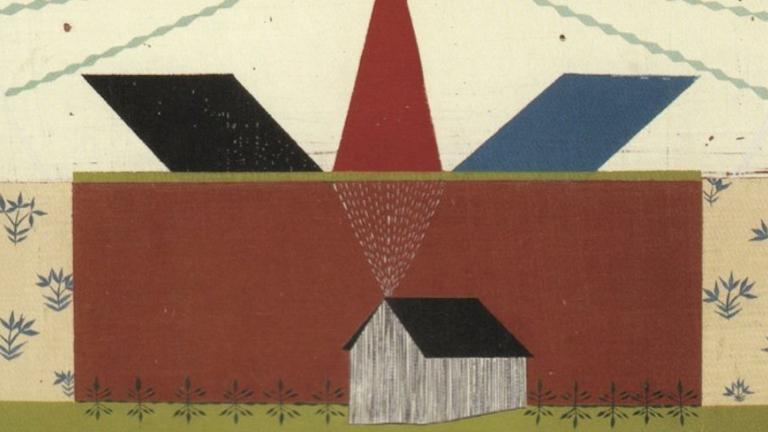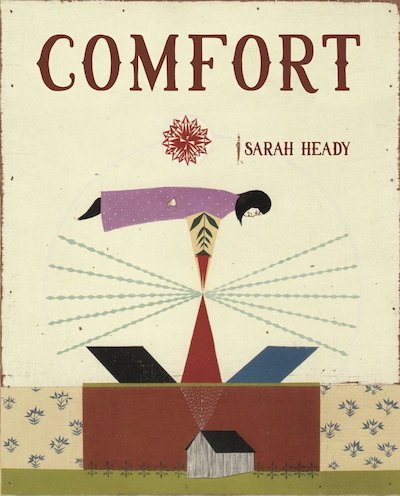
Writing Between the Lines
An Interview with Poet Sarah Heady
Sarah Heady is a poet of the lost and found. Whether people, objects, places, or times, there is a rhythm to her newest book, Comfort, of putting down and picking up, discovery and relinquishing, that permeates the text. Though Comfort is set entirely within the Great Plains, it has the undulating quality of a sea journey, the roll and pitch destabilizing what we expect of seemingly stable categories like domesticity and habitation.

“The title of the book is meant to be ironic. The book is discomfiting; it has a lot of darkness and unsettledness and questioning,” Heady says of the collection, her second after Niagara Transnational in 2013. Comfort is a poetic meditation on the way women inhabit history—their places, their roles, the way their presence lingers or is actively suppressed. Who we are and when we are is so specific, and yet Heady is able to tease out the universal from the particular, giving us tantalizing glimpses of our collective dreams and fears using history as our mirror.
The inspiration and foundation for this collection was a collection of late 19 th and early 20 th century magazines that Heady discovered in an attic during her 2013 residency at Art Farm in Marquette, Nebraska. Neglected for decades, these advice columns, recipes, sewing patters, pulp stories, and more, all aimed primarily at rural American women, have new life in Comfort, which recombines portions of found text with Heady’s own writing into a new coherence. “I have a dark imagination, and I’m obsessed with the idea of ruins. Found language is kind of a ruin,” she says.
Heady works within the tradition called Investigative Poetics (or Documentary Poetics), which begins with found materials that are transformed into new works through techniques such as erasure, redaction, and collage according to the poet’s vision. “The process of working with found language is difficult. It can be procedural—erasure by formula. For me it was much more free and not constraint-based. I would magpie, grab the stuff that attracted me and then weave it together intuitively. By decontextualizing or recontextualizing it, you can bring alive something potent or dark or ineffable that it didn’t have before. There’s a lot of distillation and cutting away; juxtaposition, ordering; those are my tools."
With those tools Heady has carved the book into the circadian division of dawn, day, and dusk, and then populated it with an unnamed woman—or, perhaps, a Greek chorus of women—seeking meaning in domestic work. “It’s so easy to poke fun at the image of the housewife or farmwife, but I think that’s a fear-based defense mechanism,” Heady says. She wants to give voice to the suffering and strength of the unnamed women who learned how to inhabit the only domain they could. That realm was actually much wider than people now reflexively believe: unlike postwar nuclear family stereotypes would suggest, there was (and is) daunting physical and emotional labor, even danger, involved in homemaking. “People are now reclaiming the domestic arts, rediscovering the importance of engaging with the materiality of everyday life.”
Materiality is strong in Comfort, in part because Heady has a passion for the particularities of history, whether old magazines or old bones. “I have an unending appetite for old stuff,” she laughs. “The common denominators for all my work are gender, place, and research or history.” Her own history is woven into the loose narrative of Comfort. Though she didn’t do so consciously, “At the time I was writing the book, I was grappling with whether I wanted to inhabit a domestic life. I was in my late 20s, going through my Saturn return and a deep dark night of the soul.” She pauses. “I was not settled.”
Settlement is a fraught word for Heady for many reasons. Comfort is critical of White settlers’ violent seizure of Indigenous lands and of what colonialism meant for the existing sovereign nations on the Great Plains. She also deconstructs the patriarchal structures undergirding the nuclear family, the ultimate means of that settlement. “The assumptions of settler colonialism warp people’s relationship to the land, to the living world, and to one another,” she says. “It was part of my process in writing Comfort to go in deep into the found language and ask: what is it to be in a partnership within these structures; what is it to inhabit a place; what is it to feel alone versus feeling lonely?”
Loneliness finds potent form in another of Comfort’s female characters, one Heady calls “the Seer.” She is loosely based on Susan Gavan, known as the “Aurora Witch” after Aurora, Nebraska, the town where she is buried. “I visited this graveyard, and on one side near the tree line, way off from the other graves, there was a single grave with a chain cordoning it off on all four sides,” Heady says. “According to legend, that’s because she was a witch, but in reality she was just a normal woman. At any rate, in Comfort this idea of a witch inhabiting the plains became a mystical figure called the Seer. She inspires other women to trust themselves and to find small ways of repairing and taking back power within the system they are given.”
The Seer, and Heady through her, considers those women toiling to bring comfort to others and asks them, “what about the comfort of agency and of being OK with yourself?” It’s neither rhetorical nor reflexive: Heady is asking her audience as well as herself to really consider the nature of comfort, what it demands of ourselves and others, what it provides in return, and whether that exchange is in balance—and worth making.
Comfort as a book, though, is a pure gift to readers, just as it seems to be a gift to Heady. “Publishing is the gift of knowing, as a writer, that you are part of a conversation, and that your work has ripples out into the world even if you can’t anticipate what they will be. That’s what I hope to get out of this process: to enjoy how it feels now that the book is out on its own, acting on the world independent of me.”
--
Check out part two of this interview.
